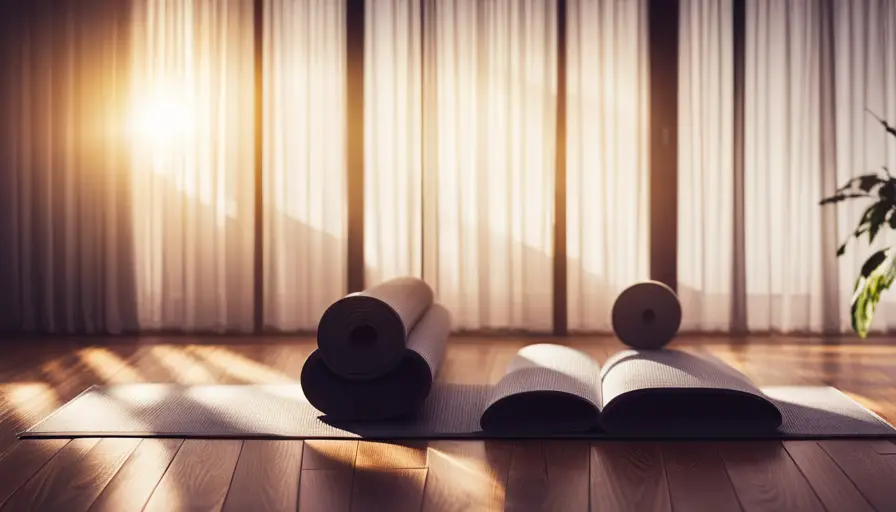Longing to roll out your yoga mat in the comfort of your own home? Wondering if it’s safe to start your yoga journey alone? Look no further.
It is safe to learn yoga at home as long as you take proper precautions and follow instructional videos or guides. It is important to listen to your body, start with beginner poses, and avoid pushing yourself too hard. It is also recommended to consult with a yoga instructor or doctor before starting a home practice.
In this piece, we will explore the benefits and potential risks of practicing yoga at home. Discover essential equipment, tips for creating a secure environment, and finding reliable online classes.
Learn how to develop a consistent routine and when it is necessary to seek professional guidance. Get ready to embrace the freedom of practicing yoga in the tranquility of your own home.
Benefits of Learning Yoga at Home
Learning yoga at home offers a multitude of benefits, including convenience and flexibility in your practice. One of the greatest advantages of practicing yoga at home is the freedom to learn at your own pace.
With self-paced learning, you have the liberty to proceed as swiftly or gradually as you desire, enabling you to fully comprehend and master each pose.
This is particularly advantageous for beginners who may feel daunted or overwhelmed in a class environment. By learning at home, you can take the time to attune to your body, adapt poses as necessary, and progress at a comfortable pace.
Moreover, finding motivation to engage in yoga becomes easier when you are within the comfort of your own abode. You have the autonomy to create a dedicated yoga space that exudes warmth and inspiration. You can personalize it with scented candles, soothing melodies, or any other elements that help cultivate the right mindset.
Additionally, practicing at home allows you to seamlessly incorporate yoga into your schedule. There is no need to rush to a studio or adjust your day to align with a class time. Instead, you have the flexibility to practice whenever it suits you best, whether it be early morning or late evening.
Overall, learning yoga at home offers the advantages of self-paced learning and finding motivation in a space that caters to your unique needs and preferences. It enables you to practice yoga on your own terms, fostering a sense of liberation and empowerment in your practice.
Potential Risks of Practicing Yoga Alone
When practicing yoga on your own, it’s crucial to understand the potential risks involved and take necessary precautions to prevent injuries.
It’s important to warm up properly before starting your practice and pay attention to your body’s signals.
Knowing your limits and not pushing yourself too hard is equally important.
Ensuring proper alignment during each pose is crucial to avoid straining your muscles and joints.
Seeking guidance from a qualified yoga instructor can provide you with the expertise and support needed to practice safely and effectively, reducing the risk of injury and optimizing the benefits of your yoga practice.
Injury Prevention Tips
To prevent injuries while practicing yoga at home, it’s crucial to warm up before each session and pay attention to your body’s limits. Warming up helps prepare your muscles, joints, and mind for the practice ahead, reducing the risk of strains and sprains. Being mindful of any discomfort or pain and adjusting your poses accordingly is also important.
Here are some extra tips to keep you safe and injury-free:
- Select an appropriate yoga mat: Look for a mat that offers sufficient cushioning and grip to prevent slips and falls.
- Practice proper alignment: Correctly aligning your body in each pose helps distribute weight evenly and prevents excessive strain on any specific area.
- Avoid pushing yourself too far: Respect your body’s abilities and progress gradually. Overstretching or muscle tears can occur if you push too hard.
- Seek guidance from a qualified instructor: If you’re new to yoga or unsure about certain poses, consider taking online classes or consulting with a certified instructor who can safely guide you.
Importance of Proper Alignment
The significance of proper alignment in yoga poses cannot be overstated. It ensures an equal distribution of weight and reduces strain on specific areas of the body. When your body is aligned correctly, it establishes a solid foundation and allows energy to flow freely.
To achieve optimal alignment, it is crucial to keep certain techniques in mind. Firstly, strive for a neutral spine by elongating through the top of your head and grounding through your tailbone. Secondly, activate your core muscles to support your spine and safeguard your lower back.
Thirdly, evenly distribute your weight between both feet or hands to prevent excessive pressure on one side of the body. Lastly, be attentive to your breath and attuned to your body’s signals. It is essential to avoid common alignment mistakes such as rounding your shoulders, collapsing your chest, and hyperextending your joints.
Benefits of Professional Guidance
The advantages of seeking professional guidance in your yoga practice are plentiful and can greatly enhance your overall experience, as well as help you attain optimal alignment. The benefits of having a knowledgeable instructor alongside you are numerous. Here are four reasons why professional guidance is crucial for your yoga journey:
- Personalized Attention: A skilled yoga instructor can offer tailored guidance, customizing the practice to meet your specific needs and objectives.
- Accurate Alignment: Proper alignment is vital for preventing injuries and maximizing the benefits of each pose. An experienced instructor can assist you in comprehending and achieving the correct alignment in every posture.
- Progression and Growth: With the guidance of a professional, you can safely and gradually progress, gradually advancing to more challenging poses as your strength and flexibility improve.
- Mindful Practice: A qualified instructor can lead you in cultivating mindfulness and awareness during your practice, aiding in deepening your mind-body connection and fostering a sense of liberation and freedom.
Investing in professional guidance not only enhances your yoga practice but also ensures a secure and fulfilling journey towards physical and mental well-being.
Essential Yoga Equipment for Home Practice
Essential Yoga Equipment for Home Practice
To embark on a fulfilling home yoga practice, you’ll require a few essential items. When it comes to choosing yoga equipment, there are affordable options that can aid in creating a cozy and efficient practice space.
Primarily, a yoga mat is indispensable. Seek out a mat that offers ample padding and support, while also providing a firm grip to prevent any slipping. A high-quality yoga mat ensures stability and helps prevent any potential injuries.
Another crucial piece of equipment is a yoga block. This versatile prop can assist in maintaining proper alignment and deepening your stretches. It also offers support during challenging poses. Opt for a foam or cork block, as they are both lightweight and durable.
A yoga strap is also a valuable tool for your home practice. It aids in enhancing flexibility and reaching those hard-to-access areas. A strap with a buckle or D-ring is recommended, as it allows you to adjust the length according to your specific needs.
Lastly, it may be worthwhile to invest in a yoga bolster. This supportive cushion can elevate restorative poses, meditation, and relaxation. It provides both comfort and stability, enabling you to fully unwind and let go.
Creating a Safe and Comfortable Yoga Space at Home
Now that you’ve gathered all the essential yoga equipment for your home practice, it’s time to create a secure and comfortable yoga space. This is vital for ensuring a peaceful and focused practice.
By creating a calming atmosphere and incorporating props and accessories, you can enhance your yoga experience and make it more enjoyable.
Here are some tips to help you create a secure and comfortable yoga space at home:
- Choose a serene and organized area: Find a space in your home where you can practice without any distractions. Clear the area of any objects that may hinder your movement or cause accidents.
- Set the ambiance with lighting and music: Utilize gentle lighting, such as candles or dimmed lamps, to create a soothing atmosphere. Play soft and relaxing music to enhance the calming ambiance.
- Utilize props and accessories: Integrate props like yoga blocks, straps, and bolsters to support your practice and make it more accessible. These props can help you modify poses and prevent injuries.
- Add personal touches: Make the space your own by incorporating elements that bring you joy and inspiration. This could be a cherished quote, a piece of artwork, or a plant. Personalizing your yoga space will make it feel more inviting and special.
Tips for Finding Reliable Online Yoga Classes
Finding trustworthy online yoga classes can be a convenient and flexible way to continue your practice from the comfort of your own space. In today’s digital age, there are numerous websites that offer yoga classes on the internet. However, it is crucial to discover reputable websites that provide high-quality instruction and a safe learning environment.
When searching for online yoga classes, look for websites that have certified and experienced instructors. Reputable websites often provide information about the instructors’ credentials, allowing you to make an informed choice. Additionally, read reviews and testimonials from other students to assess the quality of the classes offered.
One of the benefits of live online classes is the ability to interact with the instructor in real-time. Unlike pre-recorded videos, live classes allow you to receive personalized guidance and corrections, just like you would in an in-person class. This real-time interaction can enhance your learning experience and help you progress in your practice.
Another advantage of online yoga classes is the flexibility they offer. With a variety of class times and styles available, you can easily find a class that fits your schedule and preferences. Whether you are a beginner or an advanced practitioner, online classes cater to all levels, allowing you to progress at your own pace.
To conclude, finding reliable online yoga classes is essential for a safe and effective practice. Look for reputable websites that offer live classes with experienced instructors. Take advantage of the flexibility and personalized guidance that online classes provide, and continue your yoga journey from the comfort of your own space.
How to Develop a Consistent Yoga Routine at Home
Developing a consistent yoga routine at home can be achieved by dedicating time each day for your practice. By creating a structured schedule, you can ensure that you make time for your yoga practice and prioritize your well-being.
Here are some suggestions to help you develop a home yoga practice and create a consistent routine:
- Find a peaceful and cozy space in your home where you can practice without any distractions.
- Allocate a specific time each day for your yoga practice. This will help you establish a routine and make it easier to stick to your commitment.
- Begin with shorter sessions and gradually increase the duration as you become more at ease and confident in your practice.
- Experiment with various styles and types of yoga to discover what resonates with you the most. This will keep your practice interesting and enjoyable.
Seeking Professional Guidance for Home Yoga Practice
Enhancing your home yoga practice can be greatly beneficial, and seeking professional guidance is key to receiving expert advice and personalized recommendations. It’s worth considering finding virtual instructors and joining online yoga communities to take your practice to the next level.
When it comes to finding virtual instructors, the options are plentiful. Many experienced yoga teachers offer online classes and private sessions, providing personalized guidance from the comfort of your own home. It is important to seek instructors who have undergone extensive training, possess certifications, and have a strong online presence. To gain insight into their teaching style and expertise, reading reviews and testimonials can be helpful.
Apart from individual instructors, online yoga communities offer a supportive and engaging environment for your home practice. These communities often provide forums, discussion boards, and virtual events where you can connect with fellow yogis, share experiences, and ask questions. Being part of a community can bring a sense of accountability and motivation to your practice.
Conclusion
Practicing yoga at home can offer a safe and convenient way to reap its many benefits. It is crucial to be aware of the potential risks and take necessary precautions.
It is important to invest in essential yoga equipment to enhance your practice and create a comfortable space in your own abode.
With the plethora of online yoga classes available, finding reliable resources is essential. Developing a consistent routine and seeking professional guidance will further enhance your home yoga practice.
Did you know that a study conducted by the National Institutes of Health revealed that 94% of individuals who practiced yoga at home reported improved mental well-being?
So why not give it a try and experience the transformative power of yoga in the comfort of your own dwelling?




